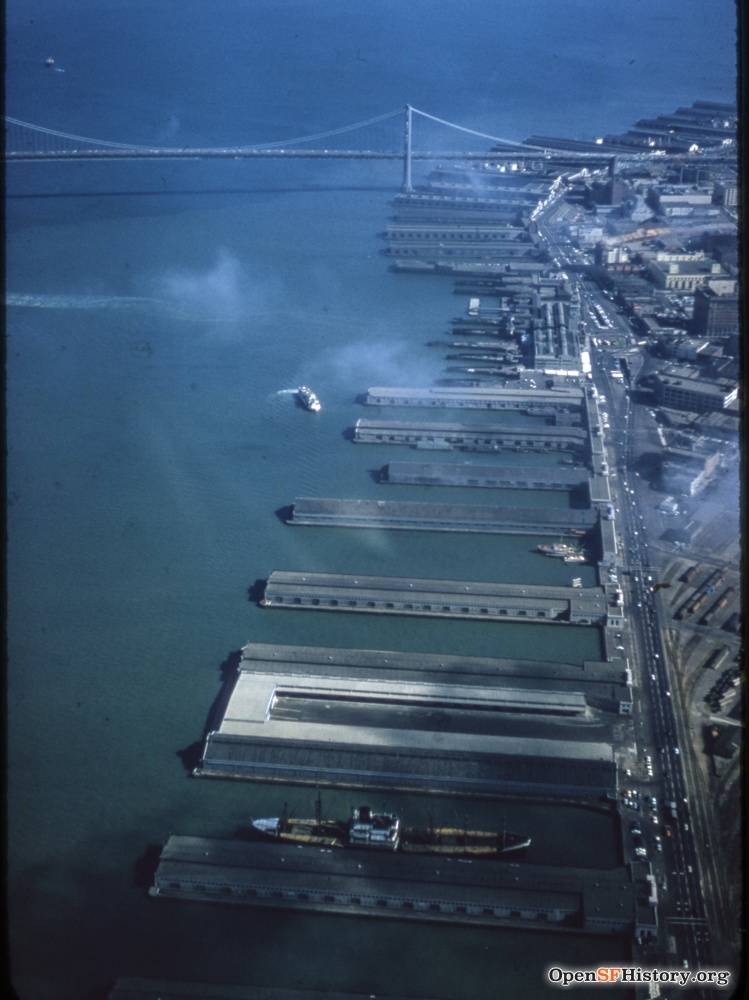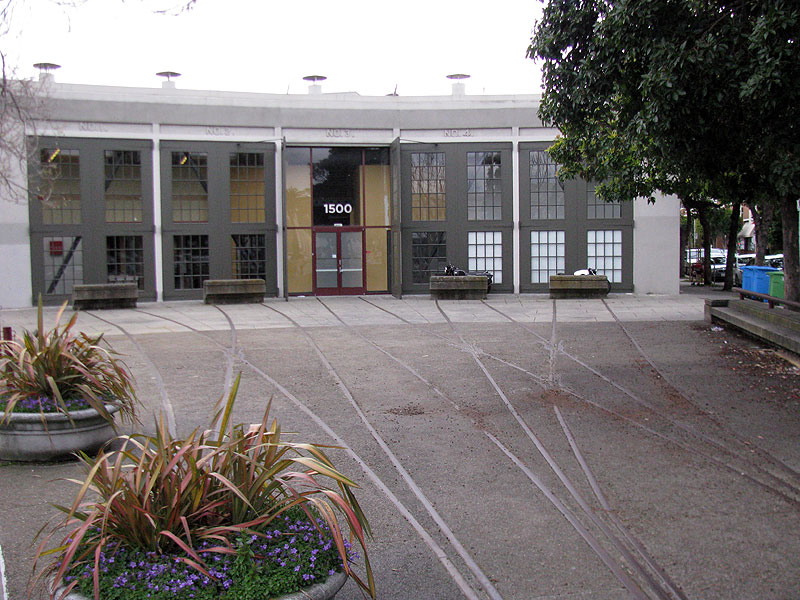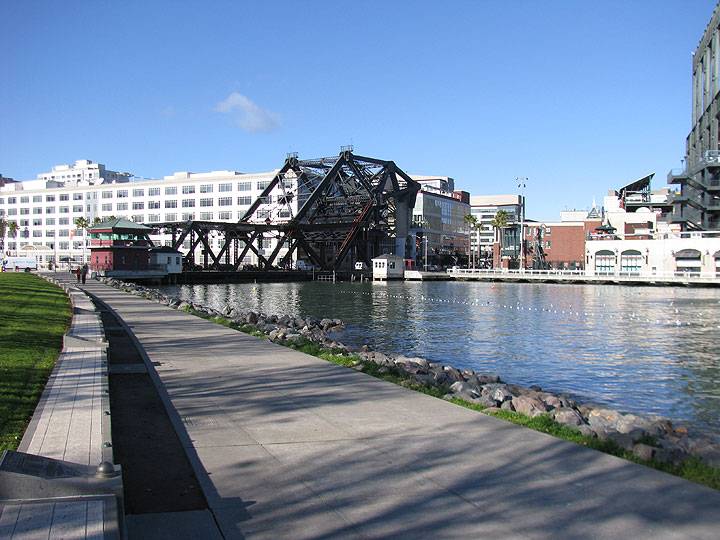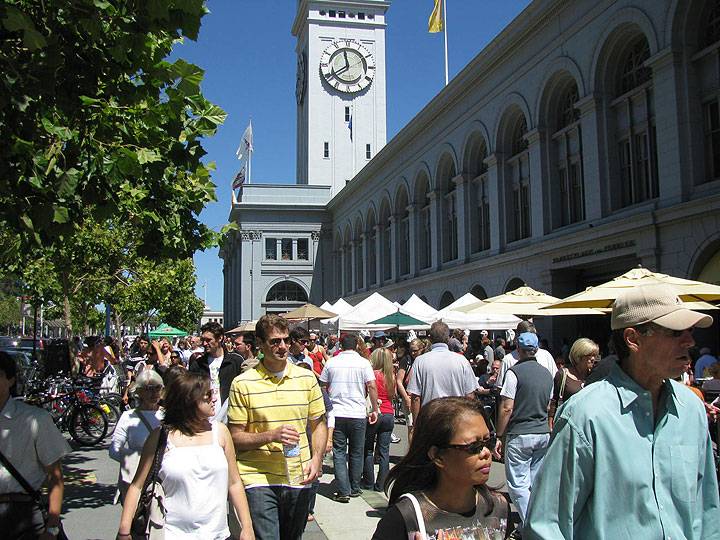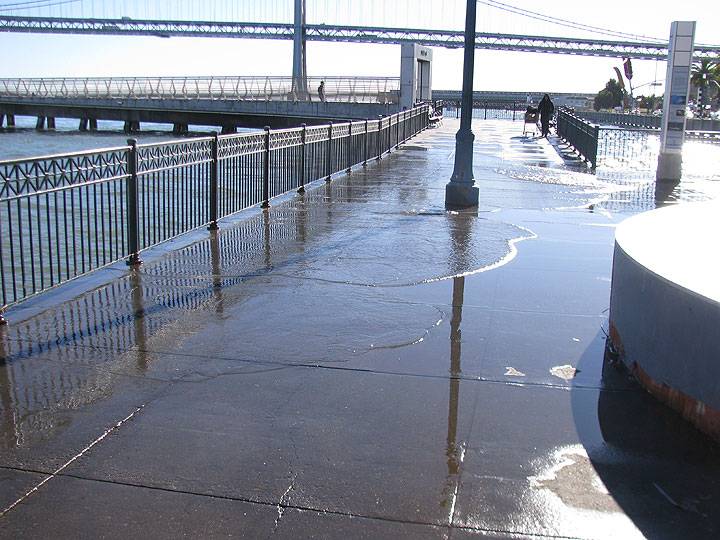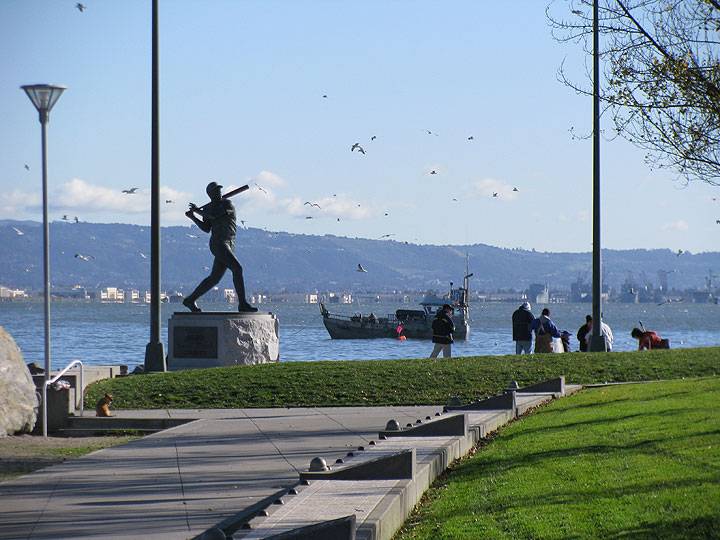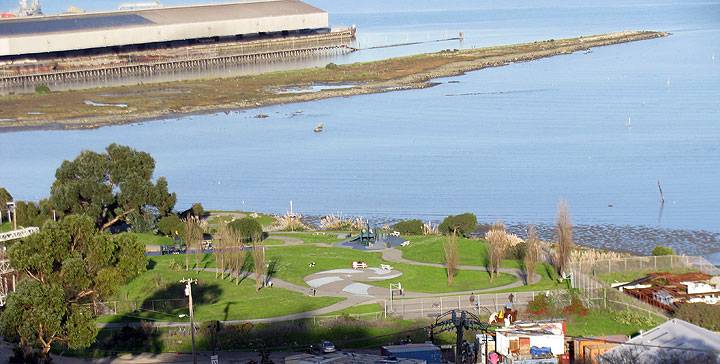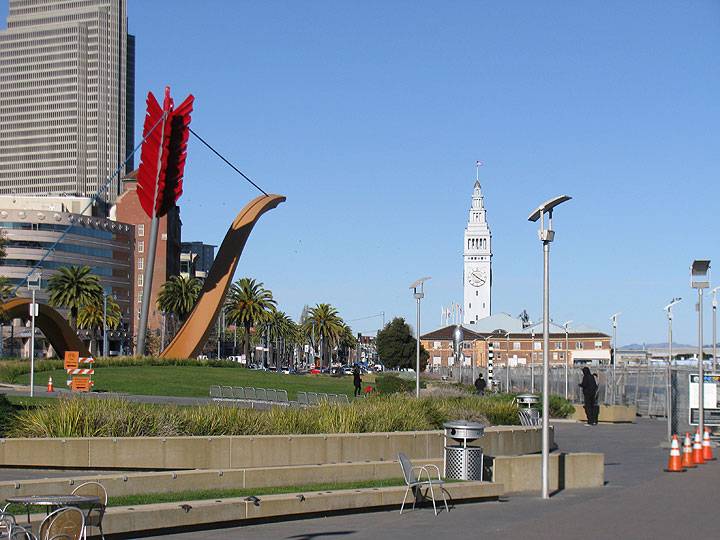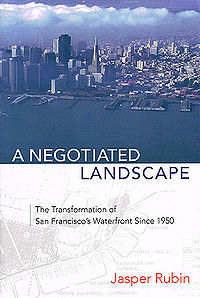The Waterfront Land Use Plan
Historical Essay
by Jasper Rubin
Aerial view of the northeast San Francisco working waterfront. The Belt Line railroad yard is at lower right, c. 1955.
Photo: courtesy OpenSFHistory.org wnp25.2056
A good example of the conversion of old industrial uses to modern office space, this is the old Belt Line Railroad roundhouse, just off the edge of the prior image's railyards.
Photo: Chris Carlsson
- The Waterfront Plan should not be prescriptive. . . it should be designed to embrace discussions of different ideas and ways in which its policies could be achieved, based on the give and take of rigorous public review and debate that San Francisco is known for.(16)
- —Port of San Francisco, Waterfront Land Use Plan
- There's the potential for something beautiful that also creates jobs.(17)
- —Don Beck, retired fireman
In response to the 1990 Proposition H, the port initiated its public planning process in January 1991. An important initial step was the formation of a twenty-seven-member Waterfront Planning Advisory Board (WPAB) based on recommendations from the board of supervisors, the mayor, and responses to a general request for participation sent to interested citizens, organizations, planners, maritime businesses, labor, and a variety of professionals. After many public workshops, draft documents, and board meetings, the port commission approved the final Waterfront Land Use Plan in 1997, which has been amended several times since. The work of the WPAB was critical to the plan's success. It is a testament to the WPAB and the importance of the undertaking that its members, representing often-adversarial groups, could reach consensus. Of course, the process had its bumps. For example Jane Morrison, wife of ex-supervisor Jack Morrison, took a rather extreme position, saying that "the waterfront should be for maritime or it should be left as open as possible. . . . It isn't there to be 'used.' It's there to be seen. . . . It wouldn't be a great disaster if nothing happened. Piers may fall into the bay."(18) But the WPAB was able to work around such difficulties, thanks in part to its chair, Robert Tufts, who was appointed by Mayor Agnos. Tufts, an attorney, and at the time, chair of the Bay Conservation and Development Commission (BCDC), was later honored by the port for his contributions. So, the result of four years of coordinated planning by BCDC, the port, Save the Bay, the San Francisco Planning Department, the WPAB and the waterfront community, led the port to describe their success as a historic achievement.(19) Indeed, the Waterfront Land Use Plan has been hailed as a resounding success by nearly everyone involved in or concerned with the waterfront.
Edge of Mission Creek along China Basin Park, paid for as part of the Giants Stadium deal, seen at right edge of photo.
Photo: Chris Carlsson
<iframe src="https://archive.org/embed/mattcollehantourofsanfrancisco?start=080" width="640" height="480" frameborder="0" webkitallowfullscreen="true" mozallowfullscreen="true" allowfullscreen></iframe>
Mat Callahan, former longshore worker and cabbie, talks about the history of the waterfront as he drives through Mission Bay along 3rd Street, crossing the 3rd Street Bridge and turning onto Berry Street to get to the Embarcadero, continuing on to beneath the Bay Bridge, in 1997! Before the ballpark had even begun demolition...
Video by Chris Carlsson
During the course of its work, the WPAB recognized that urban design, open space, and public access issues would be better dealt with separately by a special technical committee. The Urban Design Technical Advisory committee was composed of representatives from the port, the SFPD, BCDC, and Save the Bay and it produced the Waterfront Design and Access Element, which became a part of the Waterfront Land Use Plan and adopted with it under separate cover. Now all major projects are reviewed by a Waterfront Design Advisory Committee (WDAC) and analyzed for consistency with the Waterfront Land Use Plan and Waterfront Design and Access Element.
The Waterfront Land Use Plan is important for several reasons. First, it is an excellent example of a publicly informed planning process. As Diane Oshima, the port's assistant deputy director of planning recently wrote: "The Port also recognized the essential importance of creating a public process for developing the Waterfront Plan that was thorough and rational, and which incorporated authentic and meaningful public debate and participation."(20) Its creation has involved representatives of many interested publics, from labor unions to neighborhood activists to shipping line officials. It is in many ways the acme of land-use and policy planning—a consensus document. Public participation did not end with the adoption of the plan. The port also established four advisory groups responsible for different parts of the waterfront and a fifth whose concern is specifically maritime commerce.
Second, and related to the first, the plan was an incentive to coordinate policies contained in disparate documents. To this end, in 1998, the planning commission unanimously adopted conforming amendments to the General Plan, Planning Code, and Zoning Maps. Approval from the board of supervisors quickly followed. Changes to the Planning Code included removal of the requirement for conditional use permits for non-maritime use, ending a condition that had enforced a repetitive and inefficient form of project-by-project analysis. The port still has to obtain CUs that would be required in normal circumstances, for instance to allow housing in an area zoned for industry. Building height and bulks limits were unaltered.
After several years of sometimes-strained negotiations, amendments were also made to BCDC's Special Area Plan, which, along with an updated Waterfront Land Use Plan were approved in 2000. The final vote occurred in City Hall to applause from the staffs of both agencies. Coordination with BCDC was especially important because it meant that areas where commercial development could be pursued were mutually agreed.(21) As part of the agreement, Piers 24, 34, and 36 were identified for removal and changes to several other piers and buildings were included to increase access to and views of the bay. Additionally, BCDC agreed to relax some of its restrictions on what land uses were appropriate along the waterfront in return for the port's preservation of more open land and public access as part of the Waterfront Land Use Plan.(22) The goodwill and feelings of relief that pervaded the conclusion of the process did not spread to labor. Representatives of the ILWU and the Inland Boatmen's Union of the Pacific continued to voice concerns that nothing be done to disrupt facilities then being used for maritime activities and warehousing. They were not wrong in observing that "we're getting squeezed into a smaller and smaller area of the Port of San Francisco."(23)
Third, the Waterfront Land Use Plan is the first comprehensive vision for the future of the waterfront produced under the aegis of the port. As the plan itself comments, "Although many elements of the existing plans, policies, regulations and financial objectives are worthy of retention, a new approach is required to halt the continuing deterioration of Port property and to revive the debilitated state of Port finances."(24) The goals of the plan are to create: a working waterfront; a revitalized port; a diversity of activities and people; access along the waterfront; an evolving waterfront, mindful of its past and future; urban design worthy of the waterfront setting; and economic access that reflects the diversity of San Francisco.(25) The Waterfront Land Use Plan also helps clarify, for example, issues pertaining to public trust requirements, how piers are subject to BCDC's differing restrictions, and the use and definitions of maritime terms. The plan contains policies pertaining to three main categories—maritime uses, open space and public access, and commercial uses. Perhaps the plan's most significant element is that it identifies acceptable land uses according to a number of categories for every seawall lot and pier in the port's jurisdiction. This was far beyond the mandate of Proposition H, which only required the port to plan for areas subject to BCDC's authority. It was the result of a bureaucratic epiphany of sorts, one that led the port to realize the importance of the opportunity it had and of its responsibilities to the public.
So, forty years after the port started thinking about redeveloping its property, it had a document that answers the question, at least in general terms, "What to do with the waterfront?" Still, the Waterfront Land Use Plan does not apply rigid limitations with respect to possible development in its main opportunity areas. As a result of this approach, what exactly the waterfront will become is, for the time being, unknowable. The WPAB adopted this somewhat flexible framework because its members feared the possibility that detailed site-specific restrictions would fail. Instead, most important sites can accommodate a variety of uses. Fourth, the plan served as the impetus to seek funds for and carry out a series improvements and commercial developments. In part, this was achieved by identifying sites along the waterfront that would offer opportunities for mixed-use development. These areas were carefully negotiated with BCDC and city agencies to allow revenue-generating projects if they supported other public goals. For instance, a project could conceivably include non-maritime office if other trust goals were met as a result, such as the preservation of a historic resource. In an update to the port commission, director Douglas Wong pointed out that adoption of the Waterfront Land Use Plan, "along with the current real estate market and other factors, has spurred considerable interest by private developers, public agencies and citizens in revitalization of Port property."(26) His comment serves as a reminder that when opportunities and resources are available to real estate firms and developers, and other agents of top-down forces seeking to imprint their plans on the landscape, they are also available to local entities, enabling the pursuit of visions for change defined and fought for from the bottom up. The plan does more than invite development, it instead focuses on establishing the waterfront as a civic space, serving a broadly identified societal need. Thus it requires private capital to incorporate public needs into its venturing, as opposed to allowing the market to produce whatever it wants with the expectation that public benefit would trickle down. The plan optimistically emphasizes the public in its public-private partnership foundation.
Two years after his update to the commission, with successes in hand and the hope for more, Director Wong expressed his enthusiasm for the Waterfront Land Use Plan, exclaiming that "as promised, it has reawakened and revitalized the Port through an intricate series of programs that have expanded maritime operations and created new public access, entertainment, and open space along the Bay."(27) His statement was not just optimism. A number of projects that implement policies in the Waterfront Land Use Plan have been completed, and others are at various stages of development. Perhaps most significant among them has been the stunning transformation of Pier 1 and its stately neighbor, the Ferry Building. Pier l's large shed was originally used as a sugar and dry goods warehouse. When shipping relocated, it suffered the indignity of becoming a parking garage. The rehabilitation of Pier 1 was the first modern full-scale renovation of a pier shed building and the first major project subsequent to the adoption of the Waterfront Land Use Plan. It was successful because the developer, AMB Properties, an industrial real estate firm, was able to use tax credits to pay for a substantial portion of the historic rehabilitation costs and because they were able to lease some of the building as general office space.
This was allowed as part of negotiations with the State Lands Commission (SLC), which agreed that to satisfy public trust requirements, in this case historic preservation and public access, development of some office space was justifiable. The pier's apron is fully accessible to the public and bronze rail lines run through the new shed's public corridor as a reminder of its past. The building renovation, designed by local architecture and design firm SMWM, has won several awards for the quality of its historically sensitive rehabilitation. Its Class-A office space is home to the port (clearly a maritime use), AMB's headquarters, and a couple of financial and legal firms.(28)
Tourists and locals throng the thrice-weekly Farmers' Market at the Ferry Building.
Photo: Chris Carlsson
After several years of complex and difficult negotiations and financial prestidigitation, the renovation of the Ferry Building was completed in 2003. It also benefited from an agreement to allow office space in order to pay for historic rehabilitation; however, allowing office development in order to support such trust goals has been far more difficult to arrange elsewhere. The port selected local developer Wilson-Meany and partners SMWM to undertake the project. Their success is considered nothing short of splendid. The Ferry Building's historic façade was restored and the "nave bay" that ran the length of the building, essentially a grand three- story atrium, was recreated. Internal spaces that had been chopped up and isolated are whole once again. The Ferry Building houses a ground-floor marketplace, restaurants, offices, and public uses, including access to new ferry terminals, port commission meeting rooms, and circulation through and around the building. A tremendously popular farmers' market is held on Saturdays on the BART tube platform behind the building, and it is a focal point for community gatherings and civic activities. Of its restoration, the Chronicle's John King wrote, "What's striking isn't simply that a grand landmark has been restored—triumphantly so—but that it is so in sync with the city of today. . . . Now the waterfront is an amenity, a grace note in the harsh grind of city life, and the old icon again plays an active role."(29) In conjunction with the Ferry Building's rebirth, the port has recently completed its Downtown Ferry Terminal. The terminal provides modern facilities for the modest but steady flow of commuters and occasional recreational ferry passengers. To protect the new berths, the port had to construct a breakwater south of the Agriculture Building. This was cleverly disguised as a new public strolling pier, Pier 14, which was opened in 2007.
A very high ("California King") tide washes ashore adjacent to the Pier 14 pier/breakwater in January 2013.
Photo: Chris Carlsson
In 2006, a third major historic rehabilitation project was completed that saved the bulkhead buildings on Piers 1½, 3, and 5 from certain doom, for they had been severely damaged in the earthquake. The project included recreational boating slips and an impressive contribution to the Bayfront History Walk public promenade, which entices the public to walk along the water behind the bulkhead buildings. A modest amount of office space was included, but the public benefits program was also supported by historic preservation tax credits. The project has been described as a "a gift to the city."(30)
The remaking of the Ferry Building Area, including the WTPs, stands in stark contrast to proposals proffered during previous decades. Had any of those schemes been implemented, it is unlikely that the improvements now enlivening the northern waterfront would have been possible. What did not happen in this part of the waterfront, and along the Embarcadero, partly by luck but mainly by active resistance, set the stage for a transformation guided by public policy that resulted in a movement away from privatization and toward the creation of more democratized space.
The Waterfront Land Use Plan has engendered many other achievements. The plan served as the basis for the creation of the Embarcadero Historic District, officially listed in the National Register of Historic Places in 2006. Creating the district helped resolve conflicts over development where BCDC policies prevented repairs and seismic upgrades to deteriorating historic structures. Until the Waterfront Land Use Plan and Special Area Plan were brought into alignment in 2000, BCDC regulations even called for the removal of historically significant resources, such as piers and bulkhead buildings. By contrast, the updated Special Area Plan required that the historic district be created.(31)
A statue of former San Francisco Giants first baseman Willie McCovey whiffs forever at China Basin Park across from the stadium.
Photo: Chris Carlsson
Many San Franciscans would say that the Giants' ballpark is also a tremendous achievement. The ballpark opened with much fanfare in 2000, but its construction required a ballot initiative, coordination among many agencies, and a significant amount of f1exibility and creativity on the part of the team's owners and their developers. Typically, baseball stadiums and similar arenas are associated with raw deals—the public subsidizes much of the cost in return for keeping the team in their city (part of being "entrepreneurial" in the neoliberal urban condition). In this case, the project involved no public funding, although it did require public land. In fact, one issue for the owners was that, even though SLC approved the use, there was no guarantee the trust grant to the port would not be revoked sometime in the future, which meant that the state could reclaim the land.(32) While certainly a grand, material instance of popular culture and spectacle, the stadium also gracefully embraces the waterfront and is a monument to and for the public: a children's area in the park is open to the public in the off-season; large windows overlooking the outfield allow the public to watch a few innings free of charge; the building is surrounded by plazas and open space (adorned with more palm trees); and the team paid for China Basin Park, on the south shore of the channel. The stadium is linked to the East Bay by China Basin Landing, a port-developed public ferry landing and to the rest of San Francisco by a MUNI light-rail stop. Even cynics are hard put to find fault with it.
Heron's Head Park stretching into bay at top of image, India Basin Park in foreground.
Photo: Chris Carlsson
Other accomplishments of the first decade of the new millennium included the Pier 52 public boat launch; Islais Landing, a shoreline and public access improvement along lslais Creek that features a launch facility for human-powered boats; completion of Rincon Park, funded by the Gap; the South Beach Children's Play Area, part of the Rincon Point-South Beach Redevelopment Plan; Heron's Head Park, a wetlands restoration and environmental education program in the southern waterfront; salt-marsh restoration at Pier 94 near lslais Creek, where part of fill supporting the pier subsided into the bay; and Hyde Street Harbor improvements. Current works in progress include the relocation of the Exploratorium, a children's science museum from the Palace of Fine Arts to Piers 15-17; evaluation of proposals for a large mixed-use development at Seawall Lot 337-SW 337 is a 16-acre parcel near Mission Bay that is currently used as a parking lot for Giants games; a master-planning process for the sixty-acre area that includes Pier 70; and a renewed attempt to deal with street-design issues in Fisherman's Wharf. Many of these projects, and others not listed, respond to the Waterfront Land Use Plan's goals to increase public access to the waterfront and the bay by creating a series of linked open spaces and approaches. None was, or has been, particularly controversial, except those concerned with the wharf and one project proposed for SW 351, near the Ferry Building.
Rincon Park with the iconic bow and arrow by Claes Oldenburg.
Photo: Chris Carlsson
The Waterfront Land Use Plan ushered in a new stage in the evolution of waterfront planning policy and regulation. Its adoption was an articulation of local power that established a new, more democratic and public-minded discourse for planning waterfront transformation and revitalization. Its inception was the direct result of local grass roots action and a voter-approved initiative, and it was the product of a planning process that involved citizens, professionals, and advocacy groups of many stripes. The Waterfront Land Use Plan also owes its success to the hard work and patience of the Waterfront Planning Advisory Board (WPAB), port staff, and the willingness on the part of all agencies involved to rise above bureaucratic territoriality and to create a commonly agreed upon set of conditions for development.
Naturally, no plan can satisfy everyone completely, and no matter how thoughtfully crafted, policy documents usually contain inconsistencies, vagueness, or a measure of uncertainty. The planning department, for instance, has felt that the flexibility built into some of the land-use destinations creates something of a "black-box" effect; that is, for some "opportunity sites" the range of possible developments is so broad that a project sponsor could come out of the process with a proposal not supported by the General Plan. And initially at least, even the port's own commission was not entirely at ease with the plan. Commissioner Jim Herman expressed concern that it did not guarantee that the port would not become home to "Ferris wheels, roller coasters and Coney Island West."(33)
Nor is the plan an impervious shield from top-down forces, or necessarily even from the adroit politicians and clever developers indigenous to San Francisco. The SLC is still heavily influential and not much can be done to control the continuing variability of shipping and maritime activities. Moreover, though it is a document full of good intentions, the Waterfront Land Use Plan relies on public-private partnerships as the primary mechanism for achieving many of its goals. This has presented certain difficulties that have only relatively recently come to a head. So, despite its broad base of support, the Waterfront Land Use Plan is not the be all and end all of waterfront planning policy. Its many positive achievements are accompanied by some failures and keenly felt disappointments; a few are discussed below. Dealing with the issues raised by some of these projects has had an impact on the port's more recent approaches to encouraging development.
Notes
16. Port of San Francisco (PSF), "Information Presentation on a Ten-Year Review of the Waterfront Land Use Plan."
17. Retired fireman Don Beck whose boat was moored at Pier 40, quoted in John King, "Waterfront Potential S.P. Deal Buoys Hopes at Port Potential," San Francisco Chronicle (SFC), January 13, 1997.
18. "S.P. Port Veers from Shipping to Shopping."
19. PSF "Quarterly Update to Port Commission," memorandum from staff to the port commission, San Francisco, October 25, 2001.
20. PSF, "Information Briefing on the Waterfront Land Use Plan," staff memorandum to the port commission, San Francisco, August 7, 2008.
21. According to Diane Oshima, assistant deputy director of planning and development at the port, staff at the SLC, the attorney general's office, BCDC, various city agencies, as well as project sponsors themselves, together worked out how to be more flexible in deciding what kinds of projects would be allowable while respecting the values and objectives that the public trust was designed to protect and advance. This effort resulted in agreement that historic preservation should be a trust objective that could be supported by office development and general retail (personal communication with Diane Oshima, December 16, 2008).
22. One significant change was to amend the Special Area Plan to replace the "50% rule" with pier-specific open space and public access requirements in the northern waterfront. In general the "Replacement Fill Policy (50% Rule) in the San Francisco Bay Plan provides, in part, that BCDC can permit fill on publicly owned land for Bay-oriented commercial recreation and Bay-oriented public assembly, provided that the fill is a replacement pier that covers less of the Bay than was being uncovered, and the amount of Bay-oriented commercial recreation or Bay-oriented public assembly uses cover no more than 50% of the area of the Bay uncovered and the remainder (50%) of the replaced pier must be used either for public recreation, public access or open space, including open water" (BCDC, San Francisco Waterfront Special Area Plan [San Francisco, 2000], 7).
23. Jenny Stasburg, "Deal on Waterfront Development," San Francisco Examiner, July 21, 2000.
24. PSF, Waterfront Land Use Plan, 23.
25. Ibid., 4.
26. PSF, "Informational Briefing on Status of Port Planning and Development Projects," memorandum from Douglas F. Wong, Executive Director, to the port commission, San Francisco, 1999, l.
27. PSF, Annual Report (San Francisco, 2001), 4.
28. Port staffers surely winced a little at John King's quip that the space is "so industrially chic it makes you wish you were a bureaucrat." John King, "15 Seconds that Changed San Francisco," SFC, October 17,2004.
29. Ibid.
30. Carl Nolte, "3 Neglected Piers Taking on New Life," SFC, November 16, 2006, quoting the port's project manager Jennifer Sobol.
31. The idea of a historic district was not universally appreciated. Some members of the development community, architect Jeffrey Heller, and SPUR felt that historic status would limit the potential to encourage new uses along the waterfront and would place another layer of bureaucracy on the port. Their fears so far have proved unsubstantiated, especially given that the State Land Commission (SLC) has indicated historic preservation to be a trust goal.
32. Developers' fears were eventually allayed by language in the Burton Act. Essentially, the act indicated that should the transfer be revoked, the state would honor any leases already entered into legally (in other words, that supported the public trust). This led the project sponsor to request a letter from the SLC confirming that the project. because of its various public trust features, would be protected. Just about every other developer involved with projects on the waterfront now requests similar letters. This has made the SLC into a very powerful agency, with developers in the position of becoming tenants of the state. The SLC can request that nearly any condition be met before they will provide letters asserting that leases were "lawfully entered into." In the opinions of some, this has been carried to heights of ridiculousness. For instance, in one recent project that involved the historic preservation of a bulkhead building, the occupants of the rehabilitated space (used for offices) were required to raise their blinds during certain times of day so that passers-by would be able to see the building's interior structural elements.
33. Dan Levy, "Panel OKs Vision for S.F. Port," SFC, June 25, 1997. While entertainment uses such as amusement parks are allowed in certain places, his fears have so far been baseless.
Preceding essay Continue reading
Excerpted with permission from A Negotiated Landscape © 2011 Jasper Rubin and the Center for American Places at Columbia College Chicago

